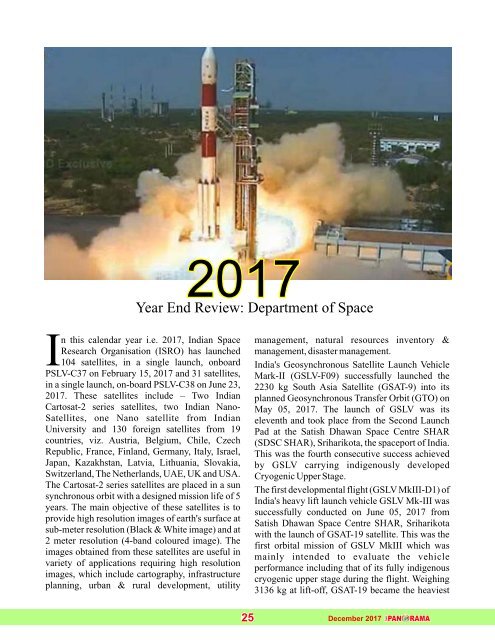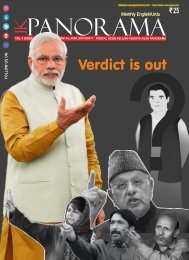JK PANORAMA DECEMBER 2017
You also want an ePaper? Increase the reach of your titles
YUMPU automatically turns print PDFs into web optimized ePapers that Google loves.
<strong>2017</strong><br />
Year End Review: Department of Space<br />
n this calendar year i.e. <strong>2017</strong>, Indian Space management, natural resources inventory &<br />
Research Organisation (ISRO) has launched management, disaster management.<br />
I104 satellites, in a single launch, onboard India's Geosynchronous Satellite Launch Vehicle<br />
PSLV-C37 on February 15, <strong>2017</strong> and 31 satellites, Mark-II (GSLV-F09) successfully launched the<br />
in a single launch, on-board PSLV-C38 on June 23, 2230 kg South Asia Satellite (GSAT-9) into its<br />
<strong>2017</strong>. These satellites include – Two Indian planned Geosynchronous Transfer Orbit (GTO) on<br />
Cartosat-2 series satellites, two Indian Nano- May 05, <strong>2017</strong>. The launch of GSLV was its<br />
Satellites, one Nano satellite from Indian eleventh and took place from the Second Launch<br />
University and 130 foreign satellites from 19 Pad at the Satish Dhawan Space Centre SHAR<br />
countries, viz. Austria, Belgium, Chile, Czech (SDSC SHAR), Sriharikota, the spaceport of India.<br />
Republic, France, Finland, Germany, Italy, Israel, This was the fourth consecutive success achieved<br />
Japan, Kazakhstan, Latvia, Lithuania, Slovakia, by GSLV carrying indigenously developed<br />
Switzerland, The Netherlands, UAE, UK and USA. Cryogenic Upper Stage.<br />
The Cartosat-2 series satellites are placed in a sun<br />
The first developmental flight (GSLV MkIII-D1) of<br />
synchronous orbit with a designed mission life of 5<br />
India's heavy lift launch vehicle GSLV Mk-III was<br />
years. The main objective of these satellites is to<br />
successfully conducted on June 05, <strong>2017</strong> from<br />
provide high resolution images of earth's surface at<br />
Satish Dhawan Space Centre SHAR, Sriharikota<br />
sub-meter resolution (Black & White image) and at<br />
with the launch of GSAT-19 satellite. This was the<br />
2 meter resolution (4-band coloured image). The<br />
first orbital mission of GSLV MkIII which was<br />
images obtained from these satellites are useful in<br />
mainly intended to evaluate the vehicle<br />
variety of applications requiring high resolution<br />
performance including that of its fully indigenous<br />
images, which include cartography, infrastructure<br />
cryogenic upper stage during the flight. Weighing<br />
planning, urban & rural development, utility<br />
3136 kg at lift-off, GSAT-19 became the heaviest<br />
03 25<br />
December <strong>2017</strong>














